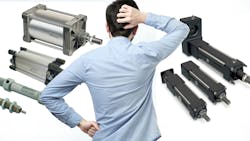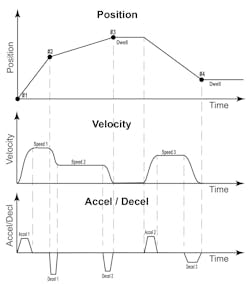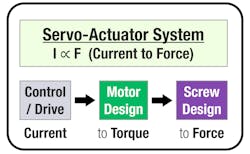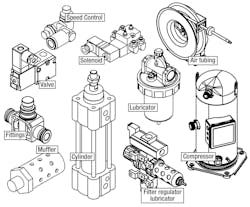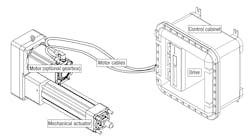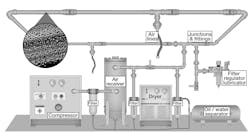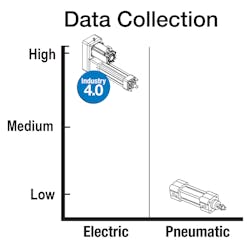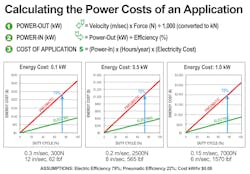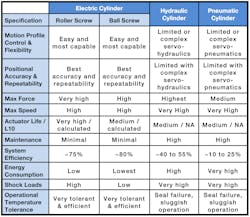A Technical Comparison: Pneumatic Cylinders and Electric Rod Actuators
When it comes to designing applications that need linear motion, engineers are often drawn into the debate about which is better for automation: pneumatic cylinders or electric linear actuators.
Pneumatic cylinders have long been used as an economical source of linear motion across a broad spectrum of manufacturing processes. They are durable and simple to install, and they provide a low-cost method of providing what’s needed for linear motion and forces. But electric rod actuators have become an economical alternative for linear motion. They can provide control and reliability advantages while meeting an application’s requirements.
Here’s a technical comparison of the performance of the two when it comes to critical criteria such as motion control; force; velocity, acceleration and deceleration; system components and footprint; reliability, life and maintenance; data collection; efficiency and utility costs; and shock and side loads. It should help design teams choose the best approach.
Motion Control
Pneumatic cylinders easily accomplish basic end-to-end positioning. Mid-stroke positioning, however, requires adding hardware to hit that third position, which results in positional performance that is not very accurate or repeatable. Servo-pneumatics can address these positioning issues, but they complicate the design and add costs which make their cost structure similar to that of electric actuators.
In addition to positional accuracy and flexibility deficiencies of pneumatic cylinders, speed control can also be a challenge and requires fine-tuning. In pneumatics, speed control is monitored through flow controls. Operators must manually dial in an application’s speed, which can be difficult to meet. Once the speed setting is adjusted, the valve regulates the pressure output required from the cylinder. Again, operators must fine-tune the cylinder to get the desired force.
Finally, a pneumatic cylinder’s repeatability of position, speed and force can be diminished by worn seals, leaks, pressure drops and spikes in the compressed air, as well as other maintenance factors. These factors often make it difficult for pneumatic cylinders to provide repeatable performance in demanding industrial environments.
Electric actuators are often chosen by designers to get control over multiple positions, accuracy, repeatability, output force, acceleration, deceleration and velocity at any time during the motion.
Electric actuators, coupled with a servo drive and motor, offer infinite control over position, as well as positional accuracy and repeatability far beyond that of pneumatic systems. Additionally, multi-axis servo controllers are readily available off-the-shelf for most modern control systems and can be easily used with several linear and rotary axes to run even the most complex motion profiles. This motion control and flexibility can be programmed into PLCs, HMIs and other controllers.
With these added capabilities, machine start-up and change-over times are fast and repeatable. This lets OEMs easily boost performance and that translates into more productive processes.
Force
Pneumatic cylinders typically operate at pressures from 80-100 psi or 5.5-7 Bar. They follow the Force = Pressure x Area fluid power principle, so the forces they can generate are easy to calculate.
However, pneumatic cylinders are typically not used at their full output force and are often oversized to improve control and ensure system operation. With pneumatic cylinders, system rigidity can be viewed as low due to the compressibility of air. This can lead to slight system delays and process variability due to the time lag needed for pressure to build.
Electric actuators can precisely control the power going to the servo motor that drives the mechanical components to create both linear movement and force. Force is generated almost instantaneously and is essentially “on demand.”
The servo controller’s closed-loop control enables precise, repeatable speeds and forces. This ensures processes are consistent cycle after cycle while preventing damage to the product or system.
When selecting electric actuators, designers should match the motor’s rpm and torque to the actuator’s screw lead and gearing. Although this step may appear to complicate the process, many companies that make actuator and servo components provide easy-to-use sizing software that takes all these variables into consideration.
Velocity, Acceleration and Deceleration
Pneumatic cylinders can generate high velocities if compressed air volume and pressure are readily available. With sufficient volume and flow, pneumatic cylinders operate at high cycle rates in basic end-to-end positioning applications without the need for detailed sizing or application engineering.
A common challenge of pneumatic systems is that the velocity of commanded motion is difficult to accurately and repeatedly control. Engineers designing pneumatic systems that will operate at high linear speeds, or with high acceleration and deceleration rates, must typically consider shock absorbers or design for the shocks and impacts that may be present. If they don’t, the resulting shocks and impacts can shorten the service life of air cylinders and associated components.
Electric actuators can precisely and accurately control velocity and the acceleration/deceleration profiles throughout the motion profile. They can also be easily changed from one speed to another without stopping or over-running position. Velocity control improves overall performance, minimizes move times, and increases cycle rates and overall productivity. And the smooth motion eliminates the potential for shocks and impacts, which improves the machine’s overall reliability and reduces risk of downtime.
Providing high speeds and forces simultaneously requires a more involved sizing process. Designers will need to assess various screw leads, gearing and servo motors that have the range of rpm and torque capabilities to meet their requirements. The combined limitations of these may restrict the actuator’s maximum velocity or thrust capabilities. In some cases, pneumatic cylinder systems offer higher overall linear velocities. However, overall cycle time can often be reduced when using electric actuators operating at similar, but lower, velocities. This is achieved by moving only the minimum amount of distance necessary instead of running end to end as is required when using air cylinders.
System Components and Footprint
Pneumatic cylinders require a cylinder, compressor or compressed air supply, valves, filters, regulators, tubing and fittings, as well as ancillary components. This results in an increased component count compared to electric actuators.
The compressor or compressed air supply takes up additional floor space at the machine, or requires a compressor room, which consumes significant plant space. When factoring the compressor into the overall footprint, pneumatics have a larger total footprint in the plant than electric actuators.
Most compressed air supplies also need overhead air hoses and air drop lines to bring compressed air to the workstation. These long hoses mean there’s more air to compress, an increase in potential leaks and a decrease in overall efficiency.
Electric actuators are physically larger than pneumatic cylinders and are rarely if ever a drop-in replacement, so they need more space. However, electric actuators have fewer components: a mechanical actuator; a motor (servo or other); an optional gearbox; cables; and a drive/amplifier, which is usually housed in a control cabinet.
Electric actuators, due to having powertrain components (power screws, bearings, etc.) inside the assembly, are longer than pneumatic cylinders. But this additional length is more than compensated for by the actuator’s much smaller overall footprint.
Reliability, Service Life and Maintenance
Pneumatic cylinders can provide rugged performance and have a long service life if properly maintained. One key element necessary for long service life is durable rod and piston seals. They must maintain proper engagement with their sealing surfaces to contain the pressure required for the given motion and force.
As the cylinder cycles back and forth, seal wear is inevitable. Any leaks decrease the cylinder’s efficiency, force, speed and responsiveness.
Predicting when seals may fail and when to carry out timely maintenance can be almost impossible. As seals wear, operators must manually adjust air flow rates and pressures on individual devices to ensure proper machine operation and process repeatability.
Many factories have preventative maintenance and replacement schedules for pneumatic cylinders to avoid unexpected downtime. The schedules must include time to test and tune systems on startup. Although periodic maintenance for pneumatic cylinders increases machine and process reliability, it also adds time, labor and costs for replacement parts, and someone must manage the maintenance schedule.
A final factor in cylinder reliability and service life is taking care of the air supply so that the compressed air is clean and free of moisture. Condensation in air lines can prematurely fail pneumatic components through corrosion and create an environmental risk through bacterial growth that might contaminate the manufacturing process.
Electric actuators can be sized for the application’s life requirements. Their main torque and force transmission elements—the screw assembly (ball or roller screw) and bearings—have dynamic load ratings (DLRs) that estimate the actuator’s service life. Designers can use the industry standard L10 life estimates to size and select components to help ensure equipment meets the life requirements. Some of these components may be greased for life. For those requiring maintenance, there are easy, in-the-field greasing methods to extend their service life in demanding applications.
A secondary wear element on electric rod-style actuators is the rod seal. It keeps water, dust and other contaminants from getting inside the actuator and damaging torque transmission components. Unlike seals on pneumatic cylinders, those in electric actuators do not have the precise sealing requirements needed to contain high pressures. Even if the seal fails, electric actuators will still function. Rod seals on most electric actuators can be easily and inexpensively replaced.
Misuse is the primary reason electric actuators fail. The most common forms of misuse are exceeding the actuator’s performance specifications for extended periods of time and damage during commissioning or installation due to inadequate attention to controls parameters.
Data Collection
Pneumatic cylinders can have proximity sensors with IO Link or an Ethernet valve bank to supply performance data. But without expensive linear transducers and other sensors to provide absolute-positioning feedback, the information reported back to the controls system is often inadequate to tightly monitor and control a process in real time.
Electric actuators commonly use servo drives that are available with off-the-shelf features that let operators monitor and send performance data to data acquisition systems. Current supplied to the motor can be easily used to track force and repeatability. The feedback device on the motor is used to accurately track position, velocity and acceleration/deceleration during the entire motion cycle at any point in time. With this data for every cycle, engineers can closely monitor actuator operation and then improve machine performance, reliability, and controls.
Efficiency and Electricity Costs
Pneumatic cylinders, the support components and the compressed air supplies typically operate at 10% to 20% efficiencies. Many factors affect this efficiency, including the number of components, leaks and air quality. As efficiency changes, so can accuracy and repeatability. Additionally, pneumatic systems must always be pressurized to guarantee specified motion and force. When the system is active, compressors must run even though many of the cylinders may not be working—an inefficient use of power.
This inefficiency is exacerbated if there are leaks. The compressor continues working, providing air pressure and volume flow while air continuously leaks. Even several small leaks can mean a significant loss of air. The increased demand on the compressor adds to electricity costs. And in large plants with complex compressed air subsystems, it can often be difficult to locate and fix all the leaks in a system.
Electric actuators typically operate in the 75% to 80% efficiency range. Thanks to the mechanical construction and torque-transmission components, this efficiency remains consistent over time.
Electric actuators only demand current to the motor when force is needed. This means that when electric actuators are at rest, they require little to no current to hold position (unless force is required), which lowers electrical use and costs.
While pneumatic systems always need energy to maintain system readiness and responsiveness, electric actuators provide motion on demand and are highly efficient when operation is required. The use of holding brakes can further increase efficiency by holding large loads in place while power to the actuator is switched off.
With increased regulation requiring many manufacturing companies to limit or cap their use of electricity which, in turn, limits compressed air use, electric actuators are often put in place to lower electricity use and meet green and energy efficiency goals.
Shock and Side Loads
Pneumatic cylinders often use an integral air cushion that lets them withstand shock loads. Shock loads in line with the cylinder’s rod are typically absorbed by the piston reacting against the compressed air in the cylinder.
Side loads due to misalignments or forces from a moment arm put stresses on both pneumatic cylinders and electric actuators. In pneumatic cylinders, they can cause premature wear or seal failure. This leads to poor velocity and force performance, an increase in leaks and premature cylinder failures. To protect against side loads, pneumatic cylinders should be aligned with the intended axis of motion.
Electric actuators, with their screw assemblies and bearings, lack any inherent protection against shocks and side loads so they can shorten the actuator’s life. In some cases, it helps to oversize the actuator to better withstand anticipated shocks. Using a roller screw also adds protection against shock loads because it provides more contact points (rollers as the load transfer element from the nut to the screw) to resist the loads. Another layer of protection can be provided by adding shock absorbers, depending on the size of shock and load.
Electric rod style actuators also don’t handle side loads well. They put lateral forces on the actuator’s front rod seal as well as the screw and nut. Increased loading on the rod seal often puts more wear on it which lets contaminants into the actuator and causes premature screw and bearing failures. Additionally, side loading on the screw and nut can shorten their life.
Summary
Pneumatic cylinders have a reputation as economical automation components. It is significantly less expensive to install them than an electric actuator/servo if there is already a source of compressed air. But pneumatic cylinders have some drawbacks compared to electric actuators. For example, they are generally limited to two-position motion profiles; they have more components; they have shorter and unpredictable lives; they need to be manually adjusted; and they consume more electricity.
Electric actuators let designers reliably control position, velocity, acceleration/deceleration and force. In addition to this flexibility, electric actuators can be correctly sized for the life of the application. Electric actuators can also use closed loop control which simplifies the task of collecting data and improving process control. They are virtually maintenance-free and highly efficient and don’t need compressed air, which lowers costs. They also often have lower total cost of ownership versus alternative pneumatic cylinders despite their higher initial purchase price.
Ryan Klemetson is a business development manager at Tolomatic Inc.
This article is part of Power & Motion's Fundamentals of Fluid Power: Pneumatics ebook; download the full guide to learn about the latest technologies and design methods for developing modern pneumatic systems.
About the Author
Ryan Klemetson
Business Development Manager, Tolomatic Inc.

Leaders relevant to this article:
